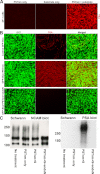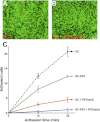Enzymatic engineering of polysialic acid on cells in vitro and in vivo using a purified bacterial polysialyltransferase
- PMID: 22851175
- PMCID: PMC3463313
- DOI: 10.1074/jbc.M112.377614
Enzymatic engineering of polysialic acid on cells in vitro and in vivo using a purified bacterial polysialyltransferase
Abstract
In vertebrates, polysialic acid (PSA) is typically added to the neural cell adhesion molecule (NCAM) in the Golgi by PST or STX polysialyltransferase. PSA promotes plasticity, and its enhanced expression by viral delivery of the PST or STX gene has been shown to promote cellular processes that are useful for repair of the injured adult nervous system. Here we demonstrate a new strategy for PSA induction on cells involving addition of a purified polysialyltransferase from Neisseria meningitidis (PST(Nm)) to the extracellular environment. In the presence of its donor substrate (CMP-Neu5Ac), PST(Nm) synthesized PSA directly on surfaces of various cell types in culture, including Chinese hamster ovary cells, chicken DF1 fibroblasts, primary rat Schwann cells, and mouse embryonic stem cells. Similarly, injection of PST(Nm) and donor in vivo was able to produce PSA in different adult brain regions, including the cerebral cortex, striatum, and spinal cord. PSA synthesis by PST(Nm) requires the presence of the donor CMP-Neu5Ac, and the product could be degraded by the PSA-specific endoneuraminidase-N. Although PST(Nm) was able to add PSA to NCAM, most of its product was attached to other cell surface proteins. Nevertheless, the PST(Nm)-induced PSA displayed the ability to attenuate cell adhesion, promote neurite outgrowth, and enhance cell migration as has been reported for endogenous PSA-NCAM. Polysialylation by PST(Nm) occurred in vivo in less than 2.5 h, persisted in tissues, and then decreased within a few weeks. Together these characteristics suggest that a PST(Nm)-based approach may provide a valuable alternative to PST gene therapy.
Figures






Similar articles
-
Differential and cooperative polysialylation of the neural cell adhesion molecule by two polysialyltransferases, PST and STX.J Biol Chem. 1998 Oct 23;273(43):28524-32. doi: 10.1074/jbc.273.43.28524. J Biol Chem. 1998. PMID: 9774483
-
A human polysialyltransferase directs in vitro synthesis of polysialic acid.J Biol Chem. 1996 Jan 26;271(4):1829-32. doi: 10.1074/jbc.271.4.1829. J Biol Chem. 1996. PMID: 8567623
-
Autocatalytic polysialylation of polysialyltransferase-1.EMBO J. 1996 Dec 16;15(24):6943-50. EMBO J. 1996. PMID: 9003770 Free PMC article.
-
Polysialic acid, a unique glycan that is developmentally regulated by two polysialyltransferases, PST and STX, in the central nervous system: from biosynthesis to function.Pathol Int. 1998 Sep;48(9):665-77. doi: 10.1111/j.1440-1827.1998.tb03967.x. Pathol Int. 1998. PMID: 9778105 Review.
-
Polysialyltransferases: major players in polysialic acid synthesis on the neural cell adhesion molecule.Biochimie. 2003 Jan-Feb;85(1-2):195-206. doi: 10.1016/s0300-9084(03)00051-8. Biochimie. 2003. PMID: 12765789 Review.
Cited by
-
Glycosphingolipids: from metabolism to chemoenzymatic total synthesis.Org Biomol Chem. 2024 Aug 22;22(33):6665-6683. doi: 10.1039/d4ob00695j. Org Biomol Chem. 2024. PMID: 39120686 Free PMC article. Review.
-
Biochemical characterization of a polysialyltransferase from Mannheimia haemolytica A2 and comparison to other bacterial polysialyltransferases.PLoS One. 2013 Jul 26;8(7):e69888. doi: 10.1371/journal.pone.0069888. Print 2013. PLoS One. 2013. PMID: 23922842 Free PMC article.
-
Moving stem cells to the clinic: potential and limitations for brain repair.Neuron. 2015 Apr 8;86(1):187-206. doi: 10.1016/j.neuron.2015.03.002. Neuron. 2015. PMID: 25856494 Free PMC article. Review.
-
Enhancement of polysialic acid expression improves function of embryonic stem-derived dopamine neuron grafts in Parkinsonian mice.Stem Cells Transl Med. 2014 Jan;3(1):108-13. doi: 10.5966/sctm.2013-0084. Epub 2013 Dec 5. Stem Cells Transl Med. 2014. PMID: 24311700 Free PMC article.
-
X-ray crystallographic structure of a bacterial polysialyltransferase provides insight into the biosynthesis of capsular polysialic acid.Sci Rep. 2017 Jul 19;7(1):5842. doi: 10.1038/s41598-017-05627-z. Sci Rep. 2017. PMID: 28724897 Free PMC article.
References
-
- Eckhardt M., Mühlenhoff M., Bethe A., Koopman J., Frosch M., Gerardy-Schahn R. (1995) Molecular characterization of eukaryotic polysialyltransferase-1. Nature 373, 715–718 - PubMed
-
- Johnson C. P., Fujimoto I., Rutishauser U., Leckband D. E. (2005) Direct evidence that neural cell adhesion molecule (NCAM) polysialylation increases intermembrane repulsion and abrogates adhesion. J. Biol. Chem. 280, 137–145 - PubMed
-
- Fujimoto I., Bruses J. L., Rutishauser U. (2001) Regulation of cell adhesion by polysialic acid: effects on cadherin, immunoglobulin cell adhesion molecule, and integrin function and independence from neural cell adhesion molecule binding or signaling activity. J. Biol. Chem. 276, 31745–31751 - PubMed
-
- Rutishauser U. (2008) Polysialic acid in the plasticity of the developing and adult vertebrate nervous system. Nat. Rev. Neurosci. 9, 26–35 - PubMed
Publication types
MeSH terms
Substances
Grants and funding
LinkOut - more resources
Full Text Sources
Other Literature Sources
Research Materials
Miscellaneous

